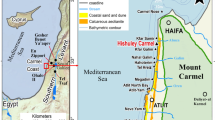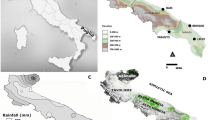Abstract
Archaeobotanical research, ethnographic observations and laboratory experiments are put together to create model sequences of olive processing, which are developed, presented and explored as an aid for the interpretation of rich archaeobotanical assemblages of Olea. We conclude that the remains of different processing stages are reasonably distinctive in the archaeobotanical record and assist in the identification of different types of olive remains, such as fragmented olive stones, the inner kernels, and fruit flesh









Similar content being viewed by others
References
Adam-Veleni P, Mangafa M (1996) Archeo eleotrivio sta Vrasna nomu Thessalonikis. (Ancient olive factory at the site of Vrasna Thessalonikis, in Greek). In: ΕLΙΑ ΚE LΑDΙ. Triimero ergasias. Kalamata, 7–9 Maiu 1993. Politistiko Technologiko Idrima ΕΤΒΑ. ΕLΑIS Α.Ε., Athens pp 92–104
Amouretti M-C, Comet G, Ney C, Paillet J-C (1984) A propos d’un pressoirà huile: de l’archeologie industrielle à l’histoire. Melanges de l’Ecole Française de Rome: antiquités 96:379–421
Asouti E (2003) Wood charcoal from Santorini (Thera): new evidence for climate, vegetation and timber imports in the Aegean Bronze Age. Antiquity 77:471–484
Astrom P (1966) Excavations in the citadel of midea. Archeologiko Deltio 21:32–35
Athanasiadis N, Gerasimidis A, Panagiotidis S (1996) I elia sta diagramata giris ke i simasia tis apo istorioarcheologiki apopsi. (The presence of olive in pollen diagrams and their archaeological interpretation). In: ΕLIA ΚE LADI. Triimero ergasias. Kalamata, 7–9 Maiu 1993. Politistiko, Technologiko Idrima ETBA. ELAIS, Α.Ε., Athens pp 78–91
Atheneos (1927–1991) The Deipnosophists. Text and translation. Gulick CB. LCL. Harvard University Press, Cambridge (Mass.)
Blitzer H (1993) Olive cultivation and oil production in Minoan Crete. In: Amouretti MC, Brun JP, Eitam D (eds) La production du vin et de l’ huile en Mediterraneé, Symp. Intern, Aix en Provence 1991. Bulletin de Correspondance Hellenique 26(Suppl):163–175
Bonias Z (2003) To eleurgio tis Argilu. (The olive factory of Argilos). In: Kamilakis P, Karapidaki L (eds) I elia kai to ladi apo tin archeotita mechri simera. Praktika diethnus sinedriu. Dimosieymata tu kendru ereynis tis elinikis laografias, 19. Athens, 1–2 October 1999. Athens Academy, Athens pp 57–62
Bookidis N, Hansen J, Snyder L, Goldberg P (1999) Dining in the sanctuary of Demeter and Kore. Hesperia 68:1–54
Brun JP (2003) Le vin et l’huile dans la Mediterranée antique Viticulture, oleiculture et procédés de transformation Collection des Hesperides. Editions Errance, Paris
Cato On Farming (1975) Text and translation: Goujard R, 1975. Paris. Belles Letters
Columella LJM (1941–1955) De Agricultura. Text and translation: Boyd Ash H, Forster ES, Heffner HE (3 vols.), LCL. Harvard University Press, Cambridge, Mass
Faklaris PB, Stamatopoulou BG (2003) I elia kai to ladi stin archea elada. (Olive tree and olive oil in ancient Greece). In: Kamilakis P, Karapidaki L (eds) I elia kai to ladi apo tin archeotita mechri simera. Praktika diethnus sinedriu. Dimosieymata tu kendru ereynis tis elinikis laografias, 19. Athens, 1–2 October 1999. Athens Academy, Athens, pp 33–47
Forbes HA (1992) The ethnoarchaeological approach to ancient Greek agriculture. In: Wells B (ed) Agriculture in ancient Greece proceedings of the seventh international symposium at the Swedish Institute at Athens, 16–17 May 1990 (Acta Instituti Atheniensis regni Sueciae, Series IN 4, XLII), Swedish Institute at Athens. Stockholm, Paul Astroms Forlag, pp 87–101
Foxhall L (1990) Olive cultivation within Greek and Roman agriculture: the ancient economy revisited. Unpublished doctoral dissertation, University of Liverpool
Foxhall L (1997) Ancient farmsteads, other agricultural sites and equipment. Appendix 1. In: Mee C, Forbes H (eds) A rough and rocky place: the landscape and settlement history of the Methana peninsula, Greece. Liverpool University Press, Liverpool, pp 257–268
Frezzotti G, Manni M (1956) Olive oil processing in rural mills. FAO Agric Devel Paper 58:49–50
Galili E, Stanley DJ, Sharvit J, Weinstein-Evron M (1997) Evidence for the earliest olive-oil production in submerged settlements off the Carmel Coast, Israel. J Archaeol Sci 24:1141–1150
Hadjisavvas S (1992) Olive oil processing in Cyprus from the Bronze Age to the Byzantine period Studies in Mediterranean Archaeology. Paul Astroms Forlag, Nicosia
Halstead P (1994) The north-south divide: regional paths to complexity in prehistoric Greece. In: Mathers C, Stoddart S (eds) Development and decline in the Mediterranean Bronze Age (Sheffield Archaeological Monographs 8). Collis, Sheffield, pp 195–219
Hamilakis Y (1995) Strategies for survival and strategies for domination: wine, oil and ‘social complexity’ in Bronze Age Crete. Unpublished doctoral Thesis, University of Sheffield
Hamilakis Y (1996) Wine, oil and the dialectics of power in Bronze Age Crete: a review of the evidence. Oxford J Archaeol 15:1–32
Hansen JM (1988) Agriculture in the prehistoric Aegean: data versus speculation. Am J Archaeol 92:39–52
Hillman GC (1981) Reconstructing crop husbandry practices from charred remains of crops. In: Mercer R (ed) Farming practice in British prehistory. Edinburgh University Press, Edinburgh, pp 123–162
Hjelmqvist H (1977) Some economic plants from the Greek Bronze Age. Appendix 1. In: Astrom P (ed) The cuirass tomb and other finds at Dendra. Part 1: the chamber tombs. Studies in Mediterranean Archaeology, vol 4, pp 123–135
Jacomet S, Kučan D, Ritter A, Suter G, Hagendorn A (2002) Punica granatum L (pomegranates) from early Roman contexts in Vindonissa (Switzerland). Veget Hist Archaeobot 11:79–92
Jones GEM (1984) Interpretation of archaeological plant remains: the application of ethnographic models from Greece. In: Van Zeist W, Casparie WA (eds) Plants and ancient man, studies in palaeoethnobotany. In: Proceeding of 6th symposium international Work Group Palaeoethnobot, Groningen 1983, Balkema, Rotterdam, pp 43–61
Kislev ME (1994–1995) Wild Olive at submerged Chalcolithic Kfar Samir, Haifa, Israel. J Israel Prehist Soc 26:134–145
Kislev ME, Simchoni O (2007) Charred by-products of olive-oil production from Area P at Bet-Shean (in press)
Kroll H (1979) Kulturpflanzen aus Dimini. Archaeo-Physika 8:173–189
Kroll H (1991) Südosteuropa. Southeast Europe. In: Van Zeist W, Wasylikowa K, Behre K-E (eds) Progress in Old World palaeoethnobotany. Balkema, Rotterdam, pp 161–177
Liphschitz N, Gophna R, Hartman M, Biger G (1991) The beginning of olive (Olea europaea) cultivation in the Old World: a reassessment. J Archaeol Sci 18:441–453
Mangafa M, Kotsakis K (1996) A new method for the identification of wild and cultivated charred grape seeds. J Archaeol Sci 23:409–418
Margaritis E (2002a) Archaeobotanical remains from the Neolithic site of Stavroupoli Thessalonikis: a preliminary report (in Greek, with English abstract). In: Grammenos D, Kotsos S (eds) Sostikes anaskafes ston Neolithiko Ekismo tis Stavroupolis Thessalonikis Archaeological Institute of Northern Greece Ministry of Culture, Thessaloniki vol 2, pp 605–612
Margaritis E (2002b) Archaeobotanical remains from Geometric Krania, Macedonia (In Greek with English abstract) Ancient Macedonia. 9th international symposium, Thessaloniki 2002. Institute for Balkan Studies, Thessaloniki
Margaritis E (2005) Olive and vine farming in Hellenistic Pieria: an archaeobotanical case study of settlements from Macedonia, Greece. Doctoral Thesis, University of Cambridge
Margaritis E, Jones MK (2006) Beyond cereals: crop-processing and Vitis vinifera L Ethnography, experiment and charred grape remains from Hellenistic Greece. J Archaeol Sci 33:784–805
Margaritis E, Jones MK (2007) Olive oil production in Hellenistic Greece: the interpretation of charred olive remains from the site of Tria Platania, Macedonia, Greece. Veget Hist Archaeobot (in press)
Martlew H, Tzedakis Y (1999) Minoans and mycenaeans flavours of their time. Greek Ministry of Culture, National Archaeological Museum, Athens
Mattingly DJ (1988) Olea mediterranea? J Roman Archaeol 1:153–161
Megaloudi F (2005) Burnt sacrificial offerings at Hellenistic times: an archaeobotanical case study from Messene, Peloponnese, Greece. Veget Hist Archaeobot 14:329–340
Megaloudi F (2006) Plants and diet in Greece from Neolithic to Classic Periods The archaeobotanical remains. BAR International Series 1516
Melena JL (1983) Olive oil and other sorts of oil in Mycenaean tablets. Minos 18:98–123
Munsell Color (2000) Munsell soil color charts. GretagMacbeth, New York
Neef R (1990) Introduction, development and environmental implications of olive culture: the evidence from Jordan. In: Bottema S, Entjes-Nieborg G, Van Zeist W (eds) Man’s role in the shaping of the eastern Mediterranean Landscape. Balkema, Rotterdam, pp 295–306
Palaima TG (1984) Tribal organisation and palatial activity. In: Shelmerdine CW, Palaima TG (eds) Pylos comes alive: industry and administration in a Mycenaean Palace. Fordham University, New York, pp 31–39
Philaniotou O (2003) Sigrotima eleotrivion ston Pirgo Chimarou stin Nakso. (Olive mills at the Tower of Chemaros on Naxos). In: Kamilakis P, Kalapidaki L (eds) I elia ke to ladi sto choro ke to chrono Praktika simposiu Dimosieymata tu kendru ereynis tis elinikis laografias, 20 Preveza, 24–26 November 2000. Theofanios Scholi, Athens, pp 73–83
Platon N (1974) Zakros. To neo minoiko anaktoro. Athens Archeologiki Eteria 5
Poulaki E (2003) Farmhouses in the area of Phila-Herakleio and Leivithra of the Macedonian Olympus. In: Adam-Veleni P, Poulaki E, Tzanavari K (eds) Ancient country houses on modern roads Ministry of Culture Archaeological museum of Thessaloniki XVI Ephorate of Prehistoric and Classical Antiquities. Published by the Archaeological Receipts Fund. Athens pp 63–70
Psaraki-Belesioti N, Gerulanu (1978) Paradosiakes kaliergies. A Benaki Museum, Athens
Renfrew JM (1966) A report on recent finds of carbonised cereal grains and seeds from prehistoric Thessaly. Thessalika 5:21–36
Renfrew C (1972a) The emergence of civilization the Cyclades and the Aegean in the third millennium b.c. Methuen, London
Renfrew JM (1972b) The plant remains. In: Warren P (ed) Myrtos: an early Bronze Age settlement in Crete. Annual of the British School at Athens, vol 7(Suppl), pp 315–317
Riley FR (2002) Olive oil production on Bronze Age Crete: nutritional properties, processing methods and storage life of Minoan olive oil. Oxford J Archaeol 21:63–75
Runnels CN, Hansen J (1986) The olive in the prehistoric Aegean: the evidence for domestication in the early Bronze Age. Oxford J Archaeol 5:299–308
Sarpaki A (1987) The palaeoethnobotany of the West House, Akrotiri, Thera. A case study. Unpublished doctoral thesis, University of Sheffield
Sarpaki A (1992) The Mediterranean triad or is it a quartet? In: Wells B (eds) Agriculture in ancient Greece proceedings of 7th international symposium Swedish Institute at Athens, 1990 Acta Instituti Atheniensis regni Sueciae, Series IN 4, 42. Stockholm. Paul Astroms Forlag pp 61–75
Sarpaki A (1999) The archaeobotanical study of Tzambakas House, Rethymnon, Crete. In: Tzedakis Y, Martlew H (eds) Minoans and Mycenaeans Flavours of their time Greek Ministry of Culture. National Archaeological Museum, Athens pp 40–41
Sarpaki A, Bending J (2004) Archaeobotanical assemblages. In: Soles J, Davaras C (eds) Mochlos IC, Period III, Neopalatial settlement on the coast The artisan’s quarter and the farmhouse at Chalinomouri The small finds. INSTAP Academic Press, Philadelphia, Pennsylvania, pp 126–131
Sordinas A (1971) Old olive mills and presses in the island of Corfu, Greece. Memphis State Univ., Anthropological Rsc. Center, Occasional Papers 5, Memphis
Terral J-F, Alonso N, Buxo de Capdevila R, Chatti N, Fabre L, Fiorentino G, Marinval P, Jorda GP, Pradat B, Rovira N, Alibert P (2004) Historical biogeography of olive domestication (Olea europaea L) as revealed by geometrical morphometry applied to biological and archaeological material. J Biogeogr 31:63–77
Vickery KF (1936) Food in early Greece. Ares Publishers, Chicago
Wilson DG (1984) The carbonization of weed seeds and their representation in macrofossil assemblages. In: Van Zeist W, Casparie WA (eds) Plants and ancient man. Balkema, Rotterdam pp 201–206
Zohary D (1995) Olive. Olea europaea (Oleaceae). In: Smartt J, Simmonds NW (eds) Evolution of crop plants, 2nd edn. Longman, London, pp 379–382
Zohary D, Hopf M (2000) Domestication of plants in the Old World, 3rd edn. Oxford University Press, Oxford
Author information
Authors and Affiliations
Corresponding author
Additional information
Communicated by S. Jacomet.
Rights and permissions
About this article
Cite this article
Margaritis, E., Jones, M. Crop processing of Olea europaea L.: an experimental approach for the interpretation of archaeobotanical olive remains. Veget Hist Archaeobot 17, 381–392 (2008). https://doi.org/10.1007/s00334-007-0122-x
Received:
Accepted:
Published:
Issue Date:
DOI: https://doi.org/10.1007/s00334-007-0122-x




